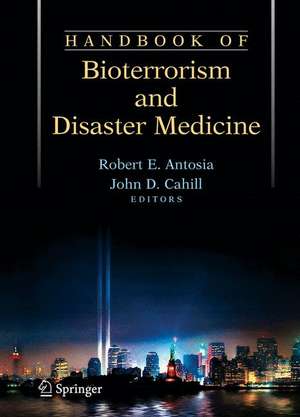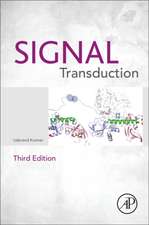Handbook of Bioterrorism and Disaster Medicine
Editat de Robert Antosia, John D. Cahillen Limba Engleză Paperback – 12 sep 2006
| Toate formatele și edițiile | Preț | Express |
|---|---|---|
| Paperback (2) | 1113.63 lei 6-8 săpt. | |
| Springer Us – 12 sep 2006 | 1113.63 lei 6-8 săpt. | |
| Springer Us – 28 oct 2010 | 1177.45 lei 6-8 săpt. |
Preț: 1113.63 lei
Preț vechi: 1172.24 lei
-5% Nou
Puncte Express: 1670
Preț estimativ în valută:
213.10€ • 222.94$ • 177.02£
213.10€ • 222.94$ • 177.02£
Carte tipărită la comandă
Livrare economică 02-16 aprilie
Preluare comenzi: 021 569.72.76
Specificații
ISBN-13: 9780387243696
ISBN-10: 0387243690
Pagini: 492
Ilustrații: XVIII, 492 p. 6 illus.
Dimensiuni: 178 x 254 x 24 mm
Greutate: 0.9 kg
Ediția:2006
Editura: Springer Us
Colecția Springer
Locul publicării:New York, NY, United States
ISBN-10: 0387243690
Pagini: 492
Ilustrații: XVIII, 492 p. 6 illus.
Dimensiuni: 178 x 254 x 24 mm
Greutate: 0.9 kg
Ediția:2006
Editura: Springer Us
Colecția Springer
Locul publicării:New York, NY, United States
Public țintă
ResearchDescriere
The Handbook of Bioterrorism and Disaster Medicine was created because we felt there was no effective handbook that covered the breadth and scope of this field. Our book incorporates concise chapters, on topics and diseases with abundant web-based references, and careful organization. We hope that all healthcare providers interested or involved with the care of victims of bioterrorism or disaster — including prehos- tal care providers, medical students, nurses, physicians, and those involved with p- lic health or humanitarian aide — find it indispensable. We wish to thank the numerous authors who contributed to this handbook. Throughout the book, consistency of style and depth provide the reader with easy and reliable access to the vast amount of information needed to understand, prepare for, and deal with a bioterrorist attack or disaster. The chapters in this book have been based on scientific studies and data when available. However, more research is ne- ed to more fully understand these complex events.
Cuprins
Introduction - I GENERAL CONCEPTS -Defining a Disaster -Early Warning Systems -Epidemiology of Disasters -Triage -Disaster Logistics -Public Health Preparedness -Intergovernmental and Government Organizations -Non-Governmental Organizations –Complex Humanitarian Emergencies - II NATURAL DISASTERS - Earthquakes -Volcanoes -Floods –Tsunamis -Hurricanes/Typhoons -Tornadoes -Drought -Firestorms and Wildfires –Heat Wave/ Hyperthermia - Winter Storm Disasters and Hypothermia III BIOEVENTS AND MANMADE DISASTERS – Epidemiology of War and Conflicts -Weapons of Mass Destruction (WMD) -Anthrax -Smallpox -Plague -Tularemia -Viral Hemorrhagic fevers -Botulism -Coxiella burnetti (Q fever) -Brucella species -Alphaviruses -Ricin toxin -Epsilon toxin -Staphylococcus Enterotoxin B (SEB) -Food-borne or waterborne agents –Melioidosis -Nerve agents -Vesicants -Pulmonary agents -Cyanides -Nuclear Agents -Radiation Accidents and exposure -Hazardous Materials Disasters (HAZMAT) -Marine disasters -Aviation disasters IV MEDICAL MANAGEMENT OF DISASTER RELATED INJURIES AND DISEASE IVa. Basic Emergency Medicine –The ABCs and Resuscitation Algorithms for Cardiopulmonary Arrest –Shock: diagnosis and management -Intravenous Fluid Requirements and Blood Products -Decontamination – Acute Inhalation Injury – Electrical Injuries -Toxicology – IVb. Infectious Diseases of Disaster -Measles -Diarrhea and Dysentery -Malaria -Meningitis and Encephalitis -Tuberculosis -HIV, Type 1 and AIDS -Sexually transmitted diseases -Schistosomiasis - Tetanus -Bite Wounds & Rabies -Tick Borne Illnesses -Leptospirosis -IVc. Basic Trauma Management – Wound Care Management – Abdominal Trauma – Thoracic Trauma – Neurotrauma – Blast Injuries – Crush Injuries – Missile Injuries – Burn Management -V PEDIATRIC CONSIDERATIONS AND DISEASES – Pediatric Problems in Developing Countries – Nutritional Assessment in Malnutrition – Treatment of Malnutritionin Children – Evalutaion and Management of Pediatric Disaster Victims – Pediatric-Specific Disaster-Related Considerations – Pediatric Specialty Team Response to Disaster -VI BIOTERROR MANAGEMENT: PSYCHOLOGICAL ASPECTS AND IMPLICATIONS -Anxiety -Depression -Post Traumatic Stress Disorder -Effects of war and separation -Bereaved Families – VII – MEDICAL AND HUMANITARIAN DISASTERS – Water, Sanitation, and Hygiene – Shelter – Refugees and Internally Displaces Populations – Child Soldiers – Reproductive Health -VIII. EDUCATION, HEALTH ISSUES AND RESOURSES –Emergency Preparedness –Syndromic Surveillance - JCAHO Emergency Management Standards – Health and Humanitarian/Disaster Worker –Immunization Schedules and Recommendations – Healthcare Worker Exposures to Blood and Body Fluids – Post-Traumatic Stress Disorder- International Law: A Primer for Healthcare Professionals – A Guide to the Worldwide Web -Index
Recenzii
From the reviews:
"The textbook, which is composed of 7 chapters, is well-written and easy to read. The chapters are designed, as noted by the editors, to be concise and well-supplemented with Web-based resources. … Overall this text is a useful and well written reference that addresses a wide variety of topics, with a concise and logical approach. In conclusion, this text is well written for those who need a concise primer on bioterrorism and disaster medicine … ." (Steven E Sittig, Respiratory Care, Vol. 52 (11), 2007)
"The textbook, which is composed of 7 chapters, is well-written and easy to read. The chapters are designed, as noted by the editors, to be concise and well-supplemented with Web-based resources. … Overall this text is a useful and well written reference that addresses a wide variety of topics, with a concise and logical approach. In conclusion, this text is well written for those who need a concise primer on bioterrorism and disaster medicine … ." (Steven E Sittig, Respiratory Care, Vol. 52 (11), 2007)
Textul de pe ultima copertă
This comprehensive volume, written by experts in the field, is the essential portable handbook on bioterrorism and disaster medicine. The volume covers all pertinent topics with meticulous organization and includes an abundance of invaluable web-based resources. Written as both a practical and clinical guide to various types of disasters, it includes planning and response procedures to help mitigate the impact of disasters on affected individuals and communities. Designed to be used in the field, all the essential aspects are included: public health, bioterror agents, chemical warfare, radioactive agents, manmade disasters, natural disasters, humanitarian disasters, infectious and tropical diseases, and basics of emergency medicine. Handbook of Bioterrorism and Disaster Medicine is the ideal tool for researchers, first responders, medical students, physicians, and other healthcare providers who work in the field.
About the Editors:
Dr. Robert Antosia is an attending physician at Beth Israel Deaconess Medical Center in Boston, Massachusetts and an Assistant Professor at Harvard Medical School. He is trained and board certified in Emergency Medicine and is a Fellow of the American College of Emergency Physicians. He is a graduate of Brown University School of Medicine and also has a Masters degree in Public Health from Harvard University. Dr. Antosia has extensive medical writing experience with numerous publications in peer-reviewed journals and textbooks, as well as prior international, public health, and disaster-related experience. He has also lectured at local, national, and international forums including England, Ireland and Italy. In addition, he has published numerous abstracts, original articles and authored several book chapters.
Dr. John D. Cahill, a specialist in international emergency medicine and tropical medicine, is an
attending physician in Emergency Medicine and Infectious Diseases at St. Luke's Roosevelt Hospital Center in New York, New York. He is assistant professor of emergency medicine at Brown Medical School in Providence, Rhode Island and is a visiting lecturer for the Royal
College of Surgeons in Ireland. He is a diplomat of the American
Board of Emergency Physicans and is a fellow of the American College
of Chest Physicians and the Royal Society of Tropical Medcine and Hygeine. Dr.
Cahill has provided medical expertise in many regions of the world,
including Africa, Asia, Europe, and South America. Dr. Cahill is a
graduate of Mount Sinai School of Medicine, USA and holds postgraduate
diplomas from the Royal College of Surgeons in Ireland, Fordham
University, and the University of Geneva, Switzerland.
About the Editors:
Dr. Robert Antosia is an attending physician at Beth Israel Deaconess Medical Center in Boston, Massachusetts and an Assistant Professor at Harvard Medical School. He is trained and board certified in Emergency Medicine and is a Fellow of the American College of Emergency Physicians. He is a graduate of Brown University School of Medicine and also has a Masters degree in Public Health from Harvard University. Dr. Antosia has extensive medical writing experience with numerous publications in peer-reviewed journals and textbooks, as well as prior international, public health, and disaster-related experience. He has also lectured at local, national, and international forums including England, Ireland and Italy. In addition, he has published numerous abstracts, original articles and authored several book chapters.
Dr. John D. Cahill, a specialist in international emergency medicine and tropical medicine, is an
attending physician in Emergency Medicine and Infectious Diseases at St. Luke's Roosevelt Hospital Center in New York, New York. He is assistant professor of emergency medicine at Brown Medical School in Providence, Rhode Island and is a visiting lecturer for the Royal
College of Surgeons in Ireland. He is a diplomat of the American
Board of Emergency Physicans and is a fellow of the American College
of Chest Physicians and the Royal Society of Tropical Medcine and Hygeine. Dr.
Cahill has provided medical expertise in many regions of the world,
including Africa, Asia, Europe, and South America. Dr. Cahill is a
graduate of Mount Sinai School of Medicine, USA and holds postgraduate
diplomas from the Royal College of Surgeons in Ireland, Fordham
University, and the University of Geneva, Switzerland.
Caracteristici
Essential portable handbook on bioterrorism and disaster medicine
Includes planning and response procedures to help mitigate the impact of disasters
Features concise chapters on all essential aspects of bioterrorism and disaster medicine
Contains abundant web-based references
Designed to be used in the field, it is an ideal tool for researchers, first responders, medical students, physicians, and other health care providers
Includes supplementary material: sn.pub/extras
Includes planning and response procedures to help mitigate the impact of disasters
Features concise chapters on all essential aspects of bioterrorism and disaster medicine
Contains abundant web-based references
Designed to be used in the field, it is an ideal tool for researchers, first responders, medical students, physicians, and other health care providers
Includes supplementary material: sn.pub/extras









